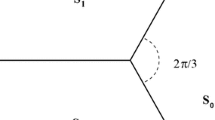Abstract
The use of the fast Fourier transform algorithm in the evaluation of the Molodensky series terms is demonstrated in this paper. The solution by analytical continuation to point level has been reformulated to obtain convolution integrals in planar approximation which can be efficiently evaluated in the frequency domain. Preliminary results show that the solution by Faye anomalies is not sufficient for highly accurate deflections of the vertical and height anomalies. The Molodensky solution up to at least the second-order term must be carried out. Part of the unrecovered deflection and height anomaly signal appears to be due to density variations, verifying the essential role of density modelling. A remove-restore technique for the terrain effects can improve the convergence of the series and minimize the interpolation errors.
Similar content being viewed by others
Bibliography and References
K. ARNOLD: Zwei geschlossene Ausdrücke für die Lotabweichungen nach der Theorie von Molodenski.Vermessungstechnik, Vol 30 (6), pp. 204–207, 1982.
R. FORSBERG: Gravity field terrain effect computations by FFT. Presented at the 1984 Fall Meeting of the AGU, San Francisco, 1984.
P. GERONTOPOULOS: Molodensky’s problem in the plane. Mitteilungen der geodätischen Institute der Technischen Universität Graz, Folge 32, Graz, 1978.
S.K. JORDAN: Fourier physical geodesy. Report No. AFGL-TR-78-0056. Reading, Massachusetts: The Analytic Sciences Corp., 1978.
A.H.W. KEARSLEY, M.G. SIDERIS, Jan KRYNSKI, René FORSBERG and K.P. SCHWARZ: White Sands revisited—A comparison of techniques to predict deflections of the vertical. UCSE Report #30007, Division of Surveying Engineering, The University of Calgary, Calgary, Alberta, 1985.
M.S. MOLODENSKII, V.F. EREMEEV and M.I. YURKINA:Methods for the study of the external gravitational field of the earth. Translated from Russian (1960), Israel program for scientific translations, Jerusalem, 1962.
H. MORITZ: Linear solutions of the geodetic boundary-value problem. Report No. 79, Department of Geodetic Science, Ohio State University, Columbus, Ohio, 1966.
H. MORITZ: On the use of the terrain correction in solving Molodensky’s problem. Report No. 108, Department of Geodetic Science, Ohio State University, Columbus, Ohio, 1968.
H. MORITZ: Nonlinear solutions of the geodetic boundary-value problem. Report No. 126, Department of Geodetic Science, Ohio State University, Columbus, Ohio, 1969.
H. MORITZ: Series solution of Molodensky’s problem. Deutsche Geodätische Kommission, A, 70, München, 1971.
H. MORITZ:Advanced Physical Geodesy. Herbert Wichman, Karlsruhe, 1980.
H. NOË: Numerical investigations on the problem of Molodensky. Mitteilungen der geodätischen Institute der Technischen Universität Graz, Folge 36, Graz, 1980.
A. PAPOULIS:Systems and transforms with applications in optics. McGraw-Hill, New York, 1968.
K.P. SCHWARZ, ed.: Techniques to predict gravity anomalies and deflections of the vertical in mountainous areas UCSE Report #30004, Division of Surveying Engineering, The University of Calgary, Calgary, Alberta, 1983.
K.P. SCHWARZ: Data types and their spectral properties. InProceedings of the International Summer School on Local Gravity Field Approximation, Beijing, China, Aug. 21–Sept. 4, 1984. UCSE Report #60003, Division of Surveying Engineering, The University of Calgary, Calgary, Alberta, 1985.
M.G. SIDERIS: Computation of gravimetric terrain corrections using fast Fourier transform techniques. UCSE Report #20007, Division of Surveying Engineering, The University of Calgary, Calgary, Alberta, 1984.
M.G. SIDERIS: A fast Fourier transform method for computing terrain corrections.Manuscripta Geodaetica, Vol. 10, pp. 66–73, 1985a.
M.G. SIDERIS: On the relationship between spectra of mean and point data with applications in computing, inverting and updating gravity field quantities. InProceedings of the International Meeting on Potential Fields in Rugged Topography, Lausanne, July 30–August 1, 1985. IGL Bulletin No. 7, pp. 82–87, Institut de Géophysique, Université de Lausanne, Lausanne, Switzerland, 1985b.
Author information
Authors and Affiliations
Rights and permissions
About this article
Cite this article
Sideris, M.G., Schwarz, K.P. Solving Molodensky’s series by fast Fourier transform techniques. Bull. Géodésique 60, 51–63 (1986). https://doi.org/10.1007/BF02519354
Received:
Accepted:
Issue Date:
DOI: https://doi.org/10.1007/BF02519354



